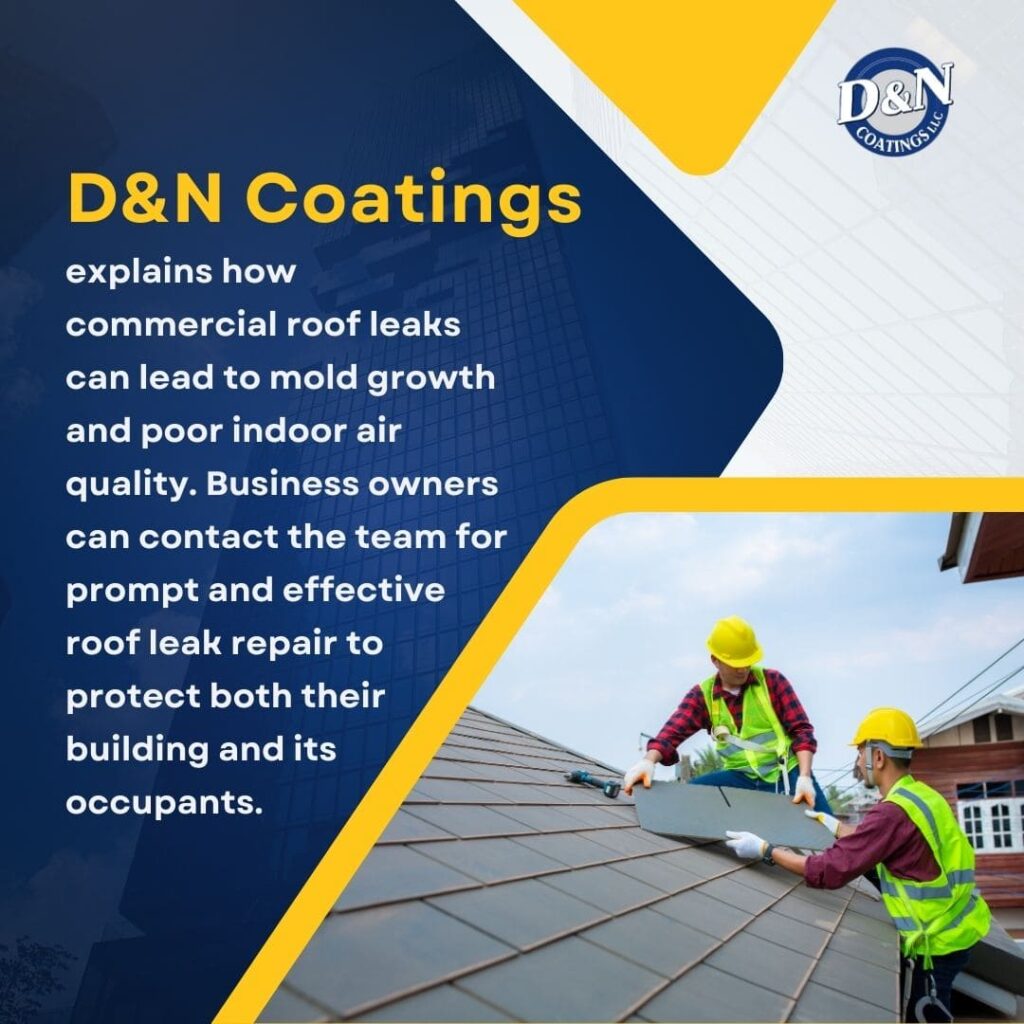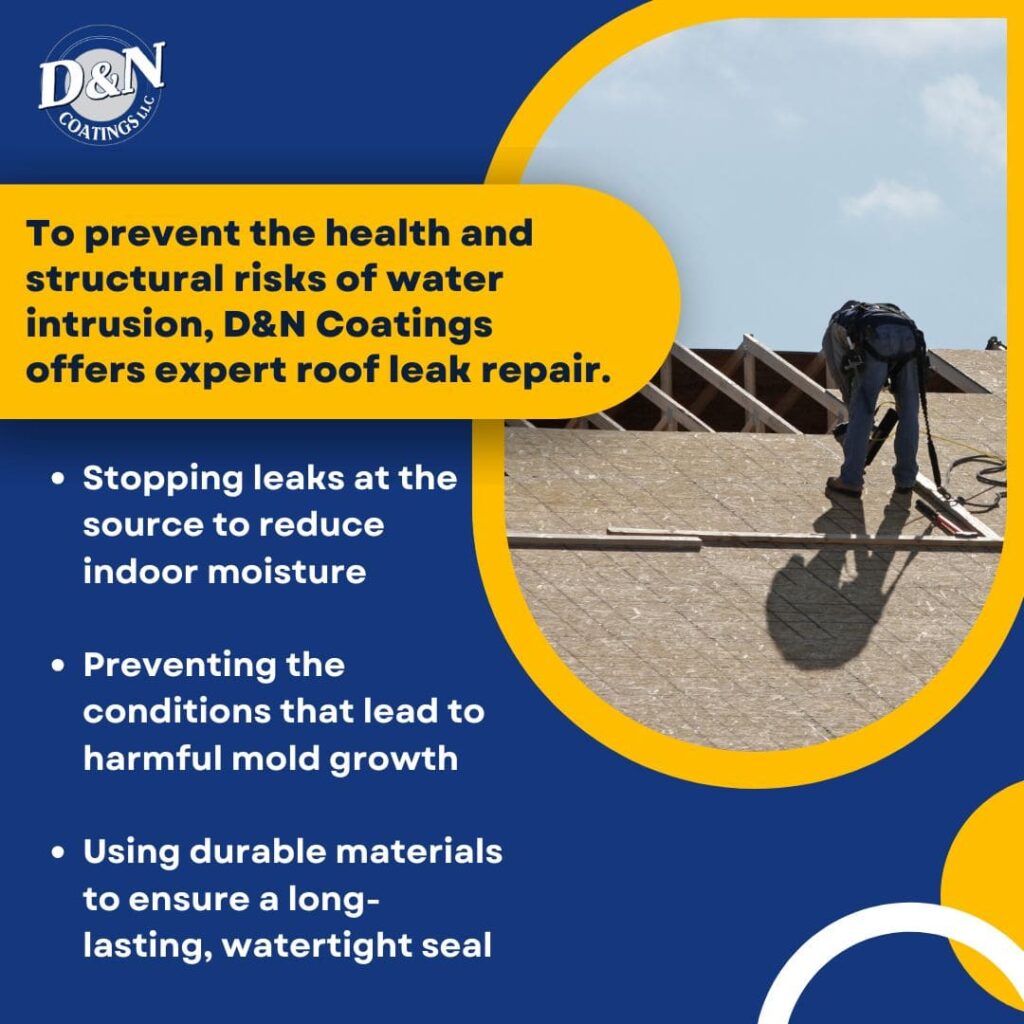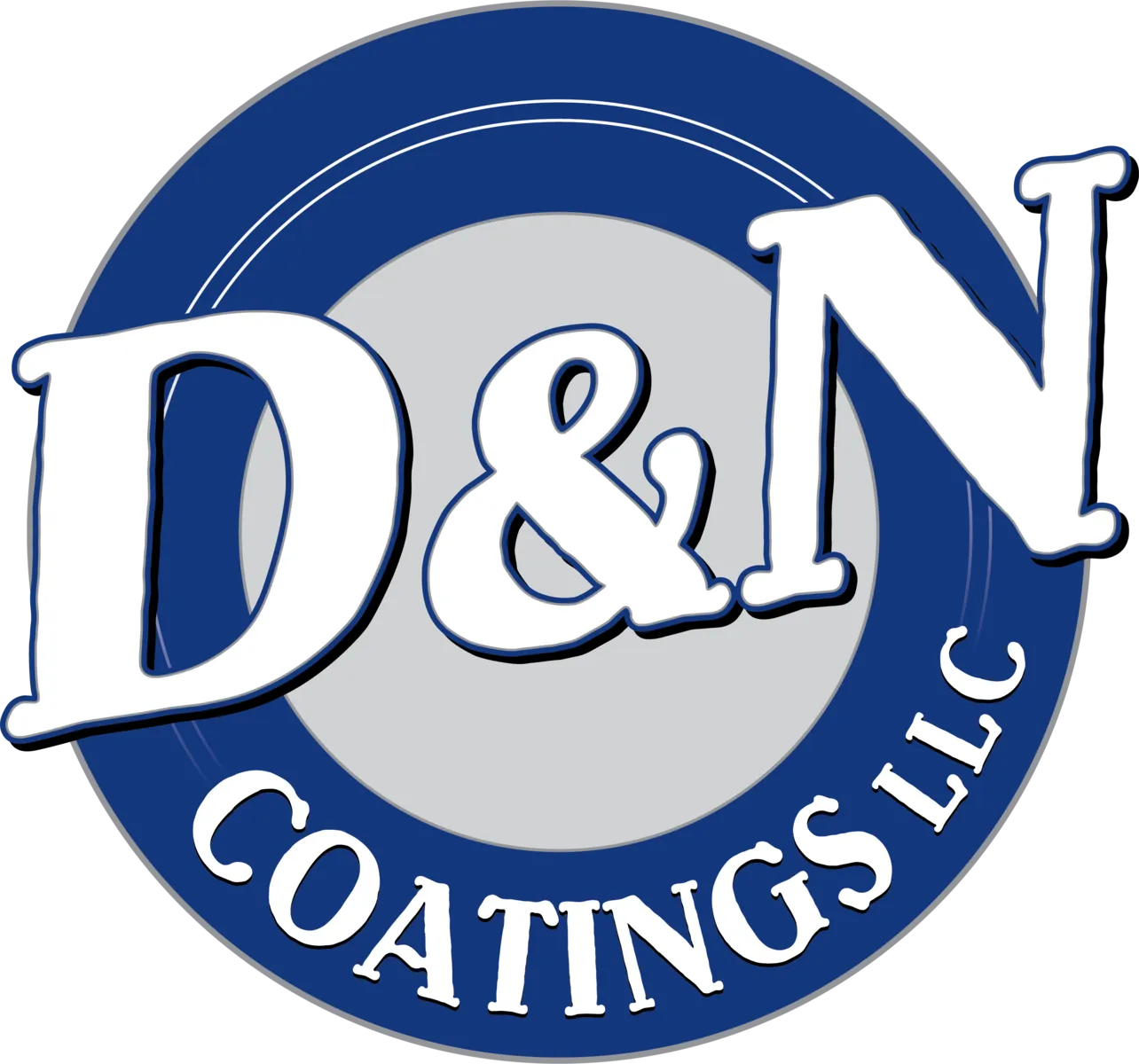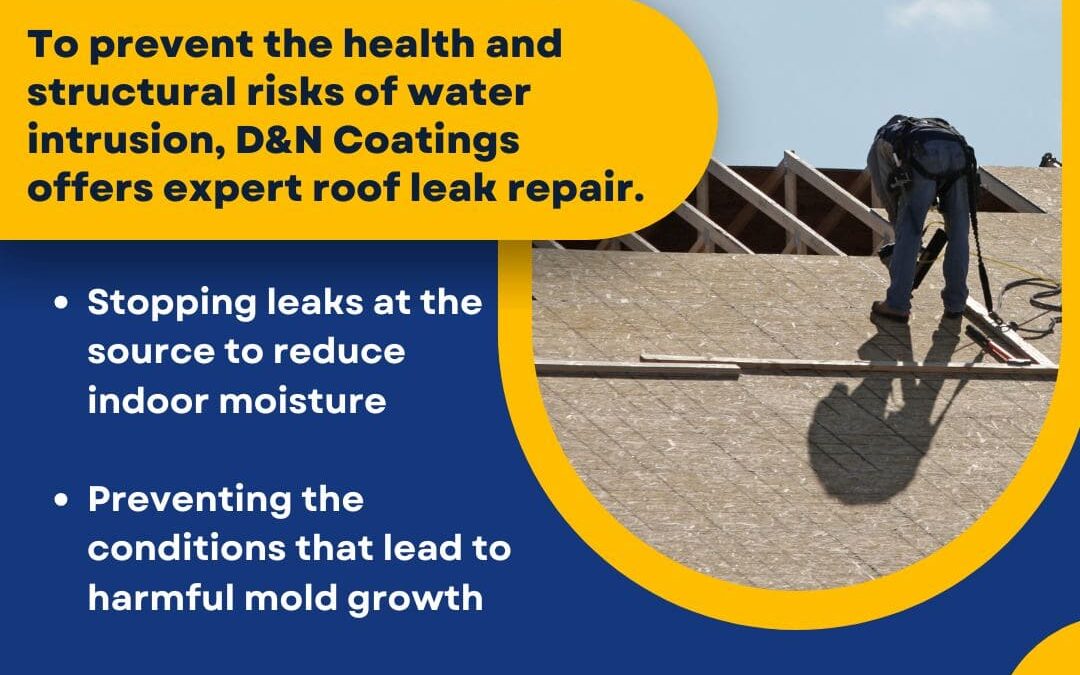D&N Coatings provides reliable commercial roof leak repair services focused on protecting buildings from water damage. Roof leaks allow moisture to seep into structures, which can degrade indoor air quality and promote mold growth on roofing materials.
Prompt and effective roof leak repair stops water intrusion, preventing damp conditions that encourage mold development. This preservation of the roof’s structure helps maintain a safer indoor environment by controlling moisture levels inside commercial properties. By addressing roof leaks quickly, D&N Coatings helps extend the life of roofing systems while reducing the risk of costly repairs linked to mold damage and poor indoor air quality.
Roof Leaks and Indoor Air Quality
Roof leaks may seem like a minor issue, but they can quickly lead to problems inside your building. Knowing how water intrusion affects indoor air quality highlights the need for timely roof leak repair.
What Happens When a Roof Leaks
Roof leaks let water enter the building, increasing indoor moisture levels. This moisture raises indoor humidity and promotes conditions that degrade air quality by increasing dampness.
When your roof lets water in, it changes the moisture balance inside the building. Water can collect in ceilings, walls, and insulation. These materials absorb moisture and become damp, leading to damage and discomfort.
According to the U.S. Environmental Protection Agency (EPA), relative humidity above 60 percent encourages the growth of mold. Once the structure remains damp, the affected areas begin to weaken, stain, or even rot over time.
How Moisture Affects Air Quality
Excess moisture increases indoor humidity, encouraging mold spores in the air. This can cause musty odors and contribute to reduced air freshness. When humidity rises due to roof leaks, it creates a suitable condition for mold.
Mold is a type of fungus that feeds on organic materials such as wood, drywall, and insulation. It releases spores, which are small airborne particles that spread easily through indoor air. These spores often produce a musty smell and can remain on surfaces long after the moisture has dried. Even small leaks can lead to larger moisture problems. Repairing the roof quickly helps reduce these risks and keeps the indoor air cleaner.
Repairing Roof Leaks
Roof leaks do more than damage your building; they compromise the structure’s performance and expose interiors to moisture. Addressing them the right way means using targeted repair methods that solve the issue at its source.

Methods to Stop Water Intrusion
Effective roof leak repair seals gaps, replaces damaged shingles, and fixes flashing to prevent water entry. Techniques include patching holes, applying sealants, and installing waterproof membranes.
When water finds a way through your roof, the repair begins by identifying the exact point of entry. This might be a missing shingle, a cracked flashing joint, or a hole caused by wear. Once located, we patch the affected area, apply protective sealants, and reinforce the vulnerable sections. On flat roofs, this often means installing a durable waterproof membrane that acts as a long-term barrier against water.
Materials and Techniques Used
Sealants like silicone and asphalt-based coatings are common in repairs. Repair methods vary based on roof type and leak location to effectively stop water intrusion. D&N Coatings works with roofing materials that match the surface type and leak condition. For example, silicone sealant is ideal for metal or commercial roofs because of its flexibility and UV resistance.
Asphalt-based coatings are often used on modified bitumen or built-up roofs, providing a solid protective layer. Whether we’re working on a sloped shingle roof or a flat commercial surface, the materials we apply match the function and condition of each roof. This approach keeps moisture out and helps preserve the integrity of your structure.
Mold Growth on Roofs
Leaks aren’t only a concern for the interior; they also create serious problems right on the roof itself. When surfaces remain damp for long periods, mold begins to take hold and damage builds over time.
How Moisture Causes Mold
Continuous moisture from leaks creates an environment for mold to grow on roofing materials. Mold feeds on wood, insulation, and other damp organic materials. If you allow moisture to collect on your roof, mold will eventually appear. It uses the trapped water to spread across materials like plywood sheathing and underlayment.
In many cases, the affected areas are not immediately visible, especially beneath layers of roofing or in tight corners around vents and seams. The more organic the material, such as wood framing or cellulose insulation, the more likely it is to support mold development when wet.
Impact of Mold on Roofing Materials
Mold weakens roofing structures by breaking down materials over time. This reduces the roof’s durability and leads to higher repair costs. Once mold sets in, it starts to break down what holds your roof together. This often results in warping, sagging, or softening of structural components like roof decks and supports.
Over time, this damage lowers the roof’s ability to shed water, which increases the risk of further leaks. Mold growth on roof sheathing commonly leads to early material failure and, if not addressed, can result in the need for partial or full roof replacement.
Preventing Mold with Repairs
Mold growth becomes a real threat when roof leaks go unnoticed. Addressing the source of moisture early gives you better control over long-term roofing performance.
Early Leak Detection
Detecting leaks early limits prolonged moisture exposure that causes mold growth. Regular inspections help find leaks before mold develops extensively. The sooner you catch a leak, the easier it is to stop mold before it spreads.
Moisture that sits for too long invites growth on any organic surface it touches. By inspecting your roof on a consistent schedule, you can spot small signs of water entry before they turn into larger issues.
Repair Strategies to Halt Mold Growth
Proper repairs stop water infiltration and help dry affected areas, removing mold-friendly conditions. Using mold-resistant materials during repair adds protection. Fixing a leak is not only about sealing the entry point. It’s also about drying the area and removing materials that mold has already compromised.
During repairs, you can replace damaged sections with moisture-tolerant materials like mold-resistant insulation or treated sheathing. This slows down future growth even if moisture reappears later.
Importance of Routine Inspections
Scheduled roof inspections catch leaks and mold development early, preventing major damage. Technologies like moisture meters improve inspection accuracy. You don’t need visible stains to know water is getting in.
Tools like moisture meters detect wet areas hidden below the surface. Regular checkups using these tools help you find leaks before mold becomes widespread. This keeps your repair costs lower and your roof in better shape.
Post-Repair Air Quality Measures
After roof repairs are completed, addressing moisture control indoors helps restore and maintain a clean, balanced environment. These steps reduce the conditions that once supported mold and dampness.
Enhancing Ventilation Systems
Improving roof and attic ventilation lowers humidity and removes trapped moisture. This reduces damp conditions that support mold growth. Ventilation in the roof and attic plays a key role in how your building handles moisture.
When airflow is limited, heat and humidity get trapped under the roof. This creates pockets of moisture that make your roof vulnerable again. You can reduce this risk by making sure ridge vents, soffit vents, or mechanical systems are working as they should.
Controlling Indoor Humidity
Using dehumidifiers and maintaining HVAC systems keeps indoor humidity below levels that promote moisture accumulation. This supports better air freshness. Roof leaks aren’t the only cause of damp air.
If the indoor environment stays too humid after repairs, it can still support unwanted moisture buildup. Using dehumidifiers in affected areas and keeping HVAC filters clean helps you maintain a drier space. You’ll also notice that the air smells cleaner and feels lighter as a result.

D&N Coatings’ Expertise in Leak Repair
At D&N Coatings, we specialize in commercial roof leak repair with a focus on durable and effective solutions. Our team conducts thorough inspections and uses proven materials and techniques to stop water intrusion before it causes further damage.
Focus on Commercial Roof Leak Repair
D&N Coatings focuses on commercial roof leak repair using proven materials and techniques. Our detailed inspections and precise repairs prevent water intrusion. When you work with us, you receive a thorough examination of your roof’s condition.
We identify even the smallest leaks and weak points that could cause trouble later. Our repair methods include patching, sealing, and replacing damaged materials. These repairs are done carefully to stop water from getting inside and to protect your building’s structure.
Approach to Long-Lasting Solutions
The company uses durable coatings and waterproofing to extend roof life and prevent leaks. Repairs are tailored to the specific roof and its needs. Not all roofs are the same, and that’s why we customize our repair approach.
We select materials that match your roof type and the environmental conditions it faces. Our durable coatings add a protective layer that holds up against weather and wear. This helps your roof stay secure and leak-free for many years after the repair.
Support and Maintenance Offered
D&N Coatings provides maintenance programs for ongoing roof monitoring post-repair. Regular inspections help prevent mold and water damage. Repairing the leak is only part of our service.
We offer maintenance plans to keep an eye on your roof after repairs. Regular checks allow us to catch new issues early, preventing costly damage and mold growth. This ongoing support helps you avoid surprises and keeps your building’s roof in good shape over time.
Reliable Roof Leak Repair Services!
Don’t let roof leaks compromise your property and indoor air quality. Contact D&N Coatings for effective roof leak repair and maintenance services tailored to your needs. Call us directly at (417) 241-3653 to schedule an inspection or request a quote.

